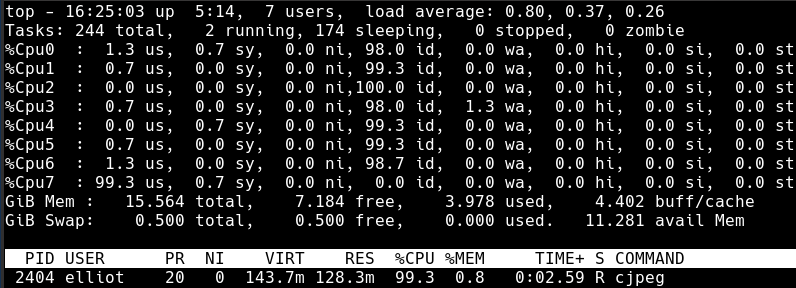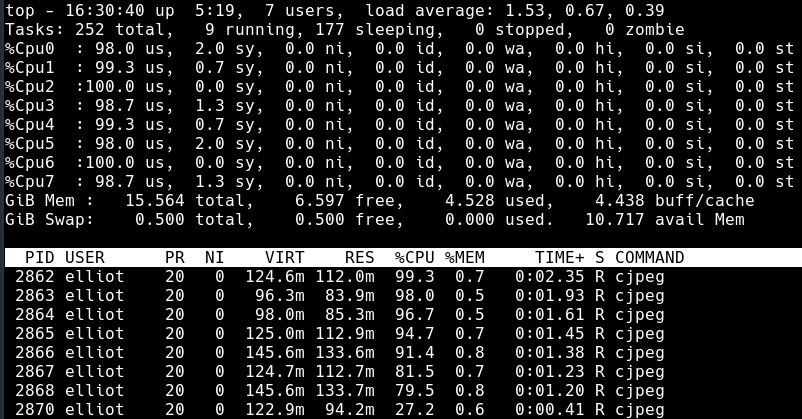https://bash-prompt.net/guides/parallell-bash
When a bash command is run it usually gets run in a single thread.
This means that it will all the processing work will get executed on a
single CPU. As CPU’s have scaled out and increased their core count this
means that only a small fraction of the available CPU resources will
get used to work on your process.
These unused CPU resources can make a big difference when the work we are trying to get done is bound by the speed that the CPU can crunch the data. This typically happens during media conversion e.g. picture and video, and data compression.
In this guide, we will look at using the bash program Parallel. Parallel works by accepting a list as input and then executing a command in parallel across all your CPU cores on that list. Parallel will even send any output to stdout in sequence so it can be piped as stdin for a further command.
Here is a typical
 As you can see, only a single of the 8 available cores is working on the single thread.
As you can see, only a single of the 8 available cores is working on the single thread.
Here is the same command run with

All the CPU cores are maxed out and there are 8 threads to match the 8 available CPU cores.
First, I created ~1GB of random data in 100 files:
Converting the same command to use
Parallel is an easy to use tool that you should add to your sysadmins tool bag as it is going to save you a great deal of time in the right situation.
These unused CPU resources can make a big difference when the work we are trying to get done is bound by the speed that the CPU can crunch the data. This typically happens during media conversion e.g. picture and video, and data compression.
In this guide, we will look at using the bash program Parallel. Parallel works by accepting a list as input and then executing a command in parallel across all your CPU cores on that list. Parallel will even send any output to stdout in sequence so it can be piped as stdin for a further command.
How To Use Parallel
Parallel takes a list as input on stdin and then creates a number of processes with a supplied command, this takes the form:list | parallel command
cat, grep, find. The results of these commands are piped from their stdout to the stdin of parallel e.g.:find . -type f -name "*.log" | parallel
-exec with find, parallel substitutes each member in the input list as {}. Here, parallel will gzip every file that find outputs:find . -type f -name "*.log" | parallel gzip {}
parallel in action will make this easier to understand.Using Parallel For JPEG Optimization
In this example, I took a collection of largish.jpg, ~10MB files and ran them through the MozJPEG JPEG image optimization tool produced by Mozilla.
This tool reduces JPEG image file size while attempting to retain the
image quality. This is important for websites in order to keep page load
times down.Here is a typical
find command to locate every .jpg file in the current directory and then run them through the image compression tool supplied in the MozJPEG package, cjpeg:find . -type f -name "*.jpg" -exec cjpeg -outfile LoRes/{} {} ';'
0m44.114s seconds to run. Here is what top looked like while it was running: As you can see, only a single of the 8 available cores is working on the single thread.
As you can see, only a single of the 8 available cores is working on the single thread.Here is the same command run with
parallel:find . -type f -name "*.jpg" | parallel cjpeg -outfile LoRes/{} {}
0m10.814s. The difference is clearly seen in this image of top:
All the CPU cores are maxed out and there are 8 threads to match the 8 available CPU cores.
Using Parallel With GZIP
If you need to compress a number of files rather than a single large one thenparallel
will speed things up. If you do need to compress a single file and want
to utilize all your CPU cores take a look at the multi-threaded gzip replacement pigz.First, I created ~1GB of random data in 100 files:
for i in {1..100}; do dd if=/dev/urandom of=file-$i bs=1MB count=10; done
find -exec command:find . -type f -name "file*" -exec gzip {} ';'
0m28.028s to complete and again only used a single core.Converting the same command to use
parallel gives us:find . -type f -name "file*" | parallel gzip {}
0m5.774s.Parallel is an easy to use tool that you should add to your sysadmins tool bag as it is going to save you a great deal of time in the right situation.

No comments:
Post a Comment